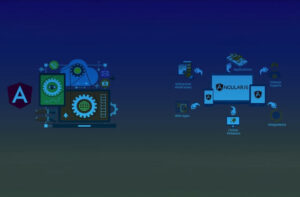Neo4j: Understanding the Basics - An Introduction
Unlike conventional relational databases, which store the data in tables, Neo4j is a graph database management system that stores the data as nodes and relationships. Imagine it as a larger and more sophisticated version of a whiteboard, where we may visually connect ideas and concepts.
Navigating Neo4j DBMS: A Closer Look at Key Features
- Nodes: Represent entities, like products, people, or companies.
- Relationships: Connect nodes and represent how they're related. For example, a "SIMILAR" relationship could connect two product nodes.
- Properties: To add more context, give nodes and relationships an attribute. A person node, for example, may contain attributes like name, age, and address.
- Cypher: Cypher is an effective query language created especially for graph databases. It makes it simple to find related data and navigate relationships. It allows us to concentrate on the data we want out of the Neo4j graph database rather than how to get it.
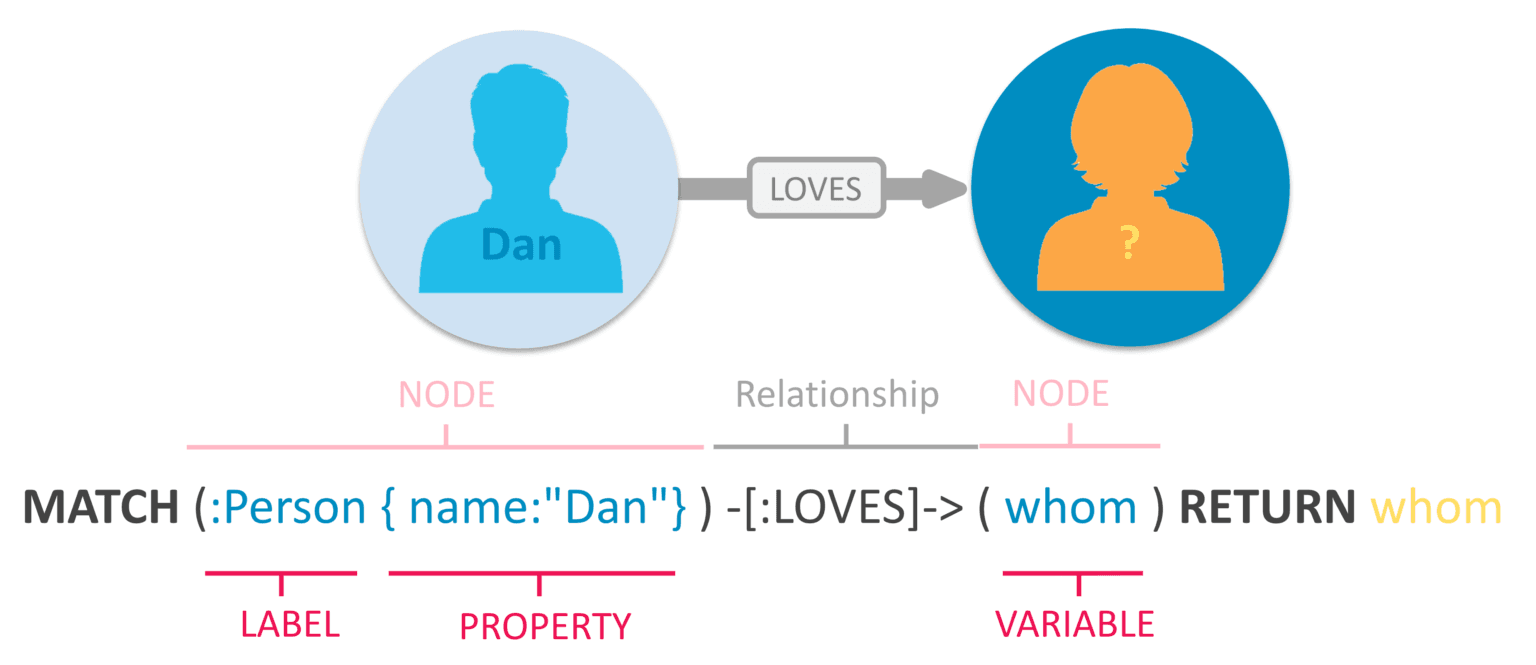
Explore Some Benefits of Neo4j here:
- Natural for Interconnected Data: Neo4j can model your data more effectively and naturally than a relational database if it has a large number of relationships.
- Faster Queries for Connected Data: The Neo4j graph model makes finding things like common connections or shortest paths much faster.
- Easier-to-understand Data Visualization: This database model makes complex supply chain relationships easier to understand by simplifying visualization.
Curious to Know, How Neo4j Enhances Electronic Manufacturing Services?
1. Complex Inter-Connectedness:
- Bill of Materials (BOM) Complexity: SQL may struggle to represent multi-level, dynamic BOMs with complex interdependencies and find alternate components. The Neo4j graph database model easily captures these relationships, allowing for faster tracing of component origins, substitution impacts, and risk analysis.
- Supply Chain Transparency: SQL may face difficulty tracking materials across multi-tiered, global supply chains with diverse suppliers and dynamic routes. Neo4j’s ability to connect entities such as suppliers, manufacturers, and logistics providers enables real-time visibility, risk mapping, and sourcing verification.
2. Dynamic and Unexpected Disruptions:
- Material Shortages and Substitutions: SQL-based systems often lack the flexibility to respond to unexpected material shortages. Neo4j graph enables the quick identification of alternative components, suppliers, and production pathways, resulting in faster response and production continuity.
- Yield and Quality Issues: Neo4j’s ability to connect process data, materials, and equipment can help identify problem areas and optimize quality control measures.
- Improved Agility and Adaptability: Respond faster to disruptions, material shortages, and changing customer demands.
Let us see Neo4j in action, and create some nodes and relationships first.
Create Nodes
// insert nodes for products
CREATE (p1:Product {name: "SmartTV X", description: "qLED panel, 2000 nits, 55 inch, android OS, 2GB RAM", mfgr_date: "2024-01-12"})
CREATE (p2:Product {name: "SmartPhone Y", description: "android smartphone, 6GB RAM, 128GB ROM, OLED display", mfgr_date: "2023-12-12"})
CREATE (p3:Product {name: "Keyboard Z", description: "RGB backlit soft touch keys for windows OS", mfgr_date: "2024-01-01"})
// insert nodes for components
CREATE (c1:Component {type: "CPU", available: TRUE, manufacturer: "ABC Tech"})
CREATE (c2:Component {type: "RAM", available: FALSE, manufacturer: "CC Electronics"})
CREATE (c3:Component {type: "SSD", available: TRUE, manufacturer: "YZ Corp"})
CREATE (c4:Component {type: "CPU", available: TRUE, manufacturer: "YZ Corp"})
CREATE (c5:Component {type: "RAM", available: TRUE, manufacturer: "ABC Tech"})
// insert nodes for specifications
CREATE (s1:Specification {type: "RAM", capacity: "8 GB", catagory: "DDR3"})
CREATE (s2:Specification {type: "CPU", clock_speed: "2.5 GHz", cores: 8})
CREATE (s3:Specification {type: "CPU", clock_speed: "3.5 GHz", cores: 4})
CREATE (s4:Specification {type: "SSD", capacity: "512 GB", catagory: "NVMe"})
// insert nodes for suppliers
CREATE (b1:Supplier {name: "AVNet sppliers"})
CREATE (b2:Supplier {name: "TIJ Broker"})
Create Relationships
// Connect products and components MATCH (p:Product), (c:Component) WHERE p.name = "SmartTV X" AND c.type in ["CPU", "RAM", "SSD"] CREATE (p)-[:REQUIRES]->(c); MATCH (p:Product), (c:Component) WHERE p.name = "SmartPhone Y" AND c.type in ["CPU", "RAM"] CREATE (p)-[:REQUIRES]->(c); MATCH (p:Product), (c:Component) WHERE p.name = "Keyboard Z" AND c.type in ["CPU", "RAM"] CREATE (p)-[:REQUIRES]->(c); // Connect components to their specifications MATCH (c:Component), (s:Specification) WHERE c.type = "CPU" AND s.type = "CPU" CREATE (c)-[:HAS_SPECS]->(s); MATCH (c:Component), (s:Specification) WHERE c.type = "RAM" AND s.type = "RAM" CREATE (c)-[:HAS_SPECS]->(s); MATCH (c:Component), (s:Specification) WHERE c.type = "SSD" AND s.type = "SSD" CREATE (c)-[:HAS_SPECS]->(s); // Connect matching specifications MATCH (s1:Specification), (s2:Specification) WHERE s1.type = "RAM" AND s2.type = "RAM" AND s1.capacity = s2.capacity CREATE (s1)-[:MATCHES]->(s2); // ...create other specification matching relationships // Connect suppliers to components MATCH (s:Supplier), (c:Component) WHERE s.name = "AVNet sppliers" AND c.manufacturer in ["ABC Tech", "YZ Corp"] CREATE (s)-[:SUPPLIES]->(c); MATCH (s:Supplier), (c:Component) WHERE s.name = "TIJ Broker" AND c.manufacturer in ["CC Electronics", "YZ Corp"] CREATE (s)-[:SUPPLIES]->(c); // Create relationships for historical substitutions MATCH (p:Product), (c1:Component), (c2:Component) WHERE p.name = "SmartPhone Y" AND c1.type = "CPU" AND c2.type = "CPU" AND c2.manufacturer = "ABC Tech" CREATE (p)-[:USED]->(c1)-[:SUBSTITUTED_FOR]->(c2);
Schema using the below command
CALL db.schema.visualization()
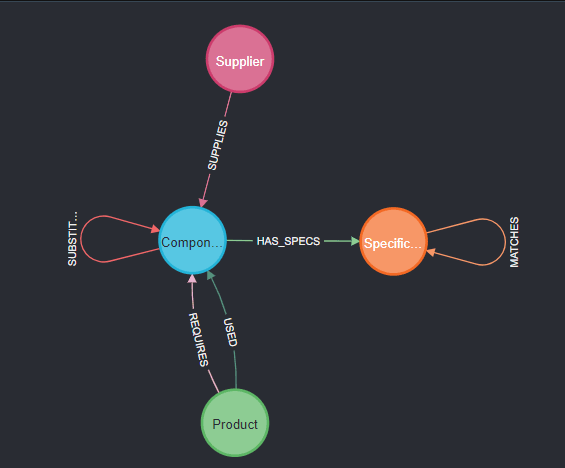
Find Alternative Components
MATCH (p:Product {name: "SmartPhone Y"})-[:REQUIRES]->(c:Component {type: "RAM"})
WHERE c.available = FALSE
MATCH (c2:Component)-[:HAS_SPECS]->(s:Specification {type: "RAM"})<-[:MATCHES]-(s2:Specification)<-[:HAS_SPECS]-(c3:Component)
WHERE c3.available = TRUE
RETURN p as Product, c as NonAvailableComponent, c3 as AvailableComponent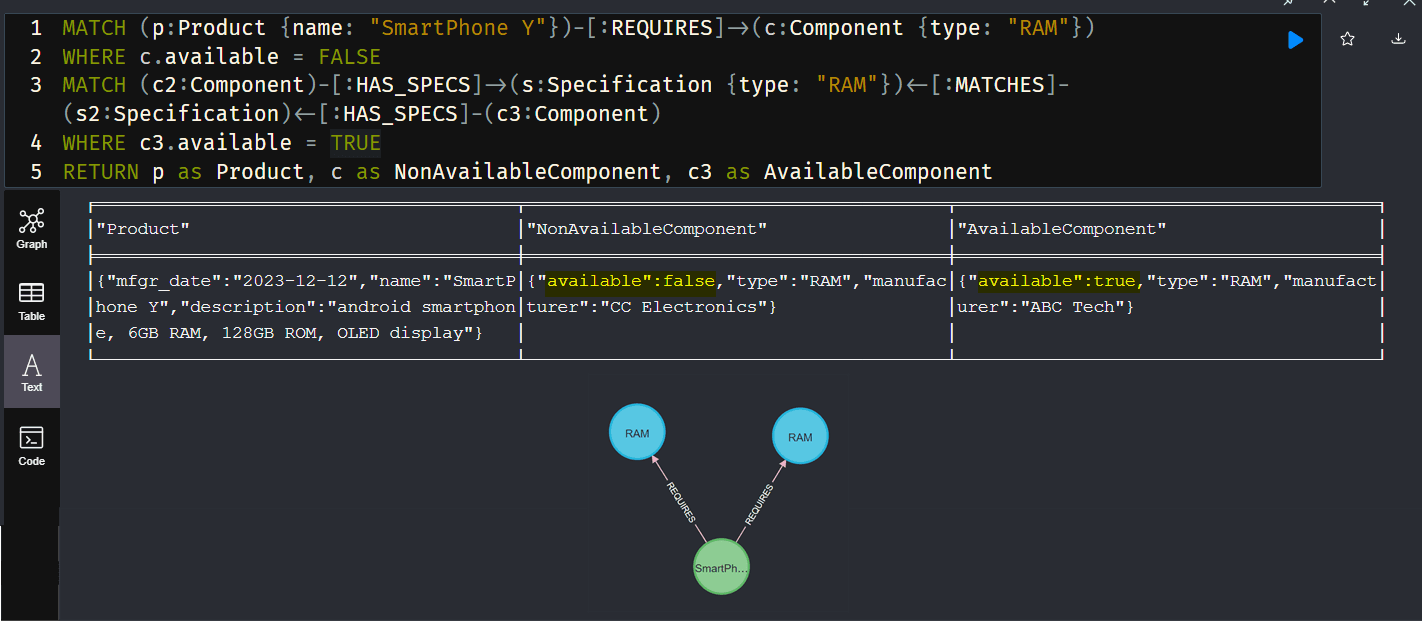
This query finds alternate components (c3) for the product (p) that require a specific unavailable component (c) based on matching technical specifications (s and s2).
Simulate Substitution Scenarios
MATCH (p:Product)-[:REQUIRES]->(c:Component)
WHERE p.name = 'SmartPhone Y'
WITH p, c MATCH (s:Supplier)-[:SUPPLIES]->(c2:Component {type: c.type})
WHERE c2.available = TRUE
RETURN p, c, s, c2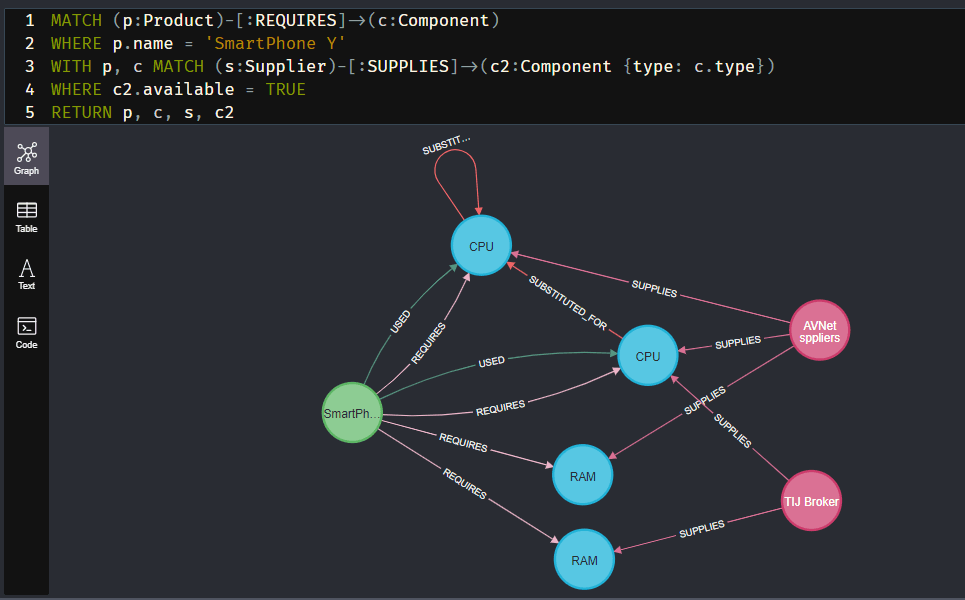
This query finds potential suppliers (s) and alternate components (c2) for the product’s required component (c) based on its type. This allows for simulating substitution scenarios and assessing their feasibility.
Analyze Historical Substitutions
MATCH (p:Product)-[:USED]-(c:Component)-[:SUBSTITUTED_FOR]->(c2:Component) WHERE p.mfgr_date > "2023-01-01" RETURN p, c, c2, count(*) AS substitution_count ORDER BY substitution_count DESC LIMIT 10
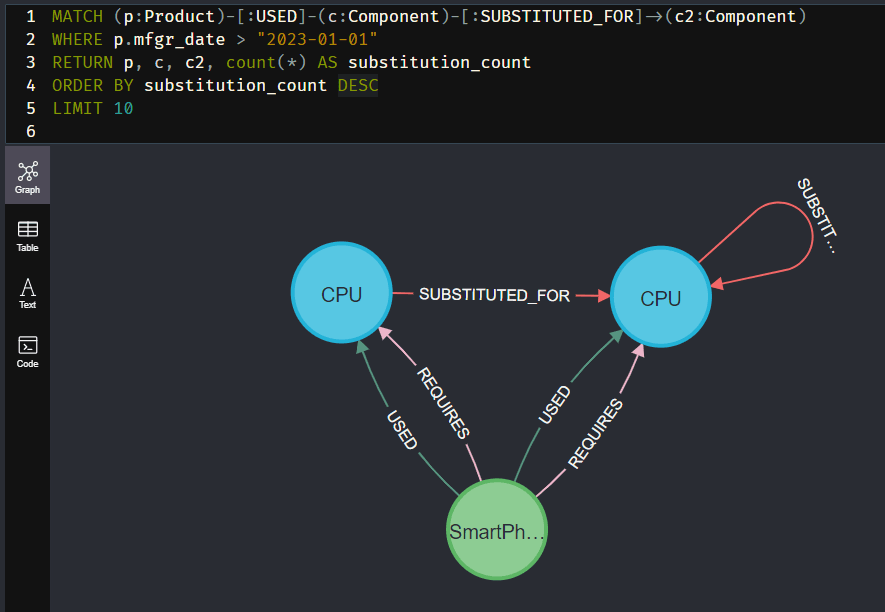
This query analyzes historical substitution data for specific products (p) and identifies the most frequently used alternative components (c2) for unavailable ones (c) for a given timeframe.
Full-Text Search Capability Of Neo4j
Neo4j’s Apache Lucene indexes provide powerful search capabilities. Lucene indexes perform well in full-text searches and sophisticated text analysis.
Here Are A Few Key Use Cases:
- Search Node and Relationship Properties: Search nodes that contain specific keywords in their names, descriptions, or other textual properties.
- Identify Patterns and Trends: Look for nodes with similar textual content across their properties.
- Rank Results Based on Relevance: Lucene ranks results based on term frequency and other criteria, displaying the most relevant matches first.
Things to consider:
- Performance Trade-Off: Lucene indexes have some overhead when compared to native schema indexes.
- Data Type Limitation: Lucene can only index string properties (or lists of strings).
Now let’s take a look at an example, we will use the same nodes created above, here we want to search the product by its description (full or partial).
To do so, we will have to create an Index first using the below query;
CREATE FULLTEXT INDEX ProductDesc FOR (n:Product) ON EACH [n.description]
CALL db.index.fulltext.queryNodes("ProductDesc", "android windows os") YIELD node, score
RETURN node.name, node.description, score
Here you can see that we have three matching results (matching keywords are highlighted) along with the match score (last column), searching is case insensitive.
Overall, Neo4j Lucene indexes enable powerful text-based search and analysis of your graph data. Consider using Lucene indexes within your Neo4j graph if your application requires rich textual content and complex search capabilities.
Conclusion
While SQL remains an important part of data management, the interconnected nature of modern EMS is a good fit for Neo4j’s graph technology. Its ability to model complex relationships, support dynamic data, and provide real-time insights can help EMS companies navigate industry challenges and achieve operational excellence.
Although it is not a silver bullet, selecting the right tools for a given problem or use case is always advisable.
FAQS
Neo4j is a graph database management system (DBMS) that stores data as nodes and relationships instead of tables and rows like traditional relational databases. This structure allows for faster and more intuitive modeling of interconnected data, making Neo4j ideal for scenarios like supply chain management, where complex relationships are common.
Neo4j uses nodes to represent entities (e.g., suppliers, products) and relationships to capture their connections (e.g., “supplies” or “manufacturers”). This Neo4j graph structure allows businesses to visualize and query intricate supply chain networks in real time. It enables tasks like identifying alternative suppliers, mapping risk areas, and tracking multi-tier supplier dependencies with ease to streamline supply chain relationship management.
- Open the Neo4j Browser or Desktop application.
- Write a Cypher query using the query editor.
- Click the “Run” button or press Shift + Enter to execute.
Neo4j addresses several challenges in EMS, such as:
- Bill of Materials (BOM) Management: Easily represents multi-level BOMs with dynamic relationships.
- Supplier Relationship Tracking: Ensures supply chain transparency by linking suppliers, materials, and logistics providers.
- Disruption Mitigation: Quickly identifies alternative components or routes during material shortages or delays.
These capabilities make Neo4j an effective tool for managing the complex, interconnected nature of EMS operations.
Neo4j supports various supply chain use cases, including:
- Risk Assessment: Mapping and analyzing supplier dependencies to identify vulnerabilities.
- Material Substitutions: Finding alternate components during shortages using graph queries.
- Quality Control: Linking production data to identify and address yield issues.
- Full-Text Search: Utilizing Lucene indexes to search and analyze textual data across the supply chain.
Neo4j DBMS stands for Database Management System, which oversees the storage, retrieval, and querying of graph data.
Key components include:
- Nodes and Relationships: Fundamental elements to represent entities and their connections.
- Properties: Attributes assigned to nodes and relationships for context.
- Cypher Query Language: A powerful, user-friendly language for querying and managing graph data, enabling users to focus on data relationships rather than the complexities of retrieval.


